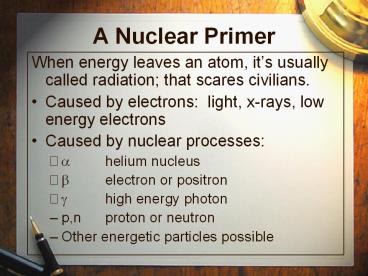A Nuclear Primer - PowerPoint PPT Presentation
Title:
A Nuclear Primer
Description:
A Nuclear Primer When energy leaves an atom, it s usually called radiation; that scares civilians. Caused by electrons: light, x-rays, low energy electrons – PowerPoint PPT presentation
Number of Views:104
Avg rating:3.0/5.0
Title: A Nuclear Primer
1
A Nuclear Primer
- When energy leaves an atom, its usually called
radiation that scares civilians. - Caused by electrons light, x-rays, low energy
electrons - Caused by nuclear processes
- ? helium nucleus
- ? electron or positron
- ? high energy photon
- p,n proton or neutron
- Other energetic particles possible
2
Radiation Units
- Geiger counter video - watch dial
- curie (Ci) and becquerel (Bq) are certain numbers
of decays per second - rad and gray (Gy) measure how much energy is
deposited in a kg of tissue. - rem and sievert (Sv) measure how much damage is
done. 1 Sv 100 rem - rem rad RBE
- Its rems that harm you
3
Radiation Sickness
- Consider whole body doses
- lt 100 rem no short-term illness
- 100 - 200 nausea, hair loss
- 300 LD50
- gt 1000 survival unlikely
- Alexander Litvinenko
4
Cancer and the linear hypothesis
- 2500 rem whole body gives 100 chance of excess
cancer - So 25 rem whole body gives 1 chance of excess
cancer - Give 100 people 25 rem each, expect one extra
cancer (20 from other causes) - Most people assume linear hypothesis at all dose
levels, so 25 mrem gives 0.001 chance of excess
cancer.
5
Fission and fusion energy
- Fission occurs when a nucleus splits
- Fragments have less mass than the original
nucleus E mc2 - Fusion occurs when two lighter nuclei fuse into a
single heavier nucleus. - Again, mass goes missing and comes out as energy
(lots of it) - How can this happen in both cases?
6
(No Transcript)
7
- Fusion generates lots of relatively clean power,
but requires high temperature and probably
magnetic confinement - Fusion is the power source of stars
- Fusion bombs are the most powerful ever made
8
Chain reactions
- The power of repeated doubling
- Neutrons initiate fission, and fission creates
more neutrons - Runaway chain reaction is a bomb
- Critical mass is required (15 kg for U-235, 5 kg
for Pu-239) to ensure enough neutrons are
absorbed - Make critical mass with gun or with implosion
9
How to make a bomb
- Enrich uranium to increase U-235
- Gas centrifuges
- Modern, efficient, but need strong material for
their construction - Calutrons
- Slow but sure Saddam tried this method
- Use plutonium
- Implosion must be used hard to do
- Use fission bomb to start a fusion reaction
(H-bomb)
10
Bomb damage
- 20 kiloton about a mile away
- Light/x-ray pulse
- Thermal pulse
- Blast wave
- Radioactive fallout
- New York City example
- The only winning move is not to play the game
11
A reactor hodge-podge
- Fast vs. slow neutrons
- Bombs need fast neutrons to get enough doublings
in a short time - Reactors generally use slow neutrons, since they
are absorbed more readily by the smaller fraction
of U-235 - Moderators
- Used to slow the neutrons down - thermal
- Water, heavy water, graphite
12
A reactor hodge-podge, p.2
- Control rods
- Absorb neutrons to control the reaction
- Neutron absorbed by U-238 gives Pu-239 --
breeder reactor - Sometimes uses fast neutrons. Less safe but more
efficient. - Depleted uranium bullets































